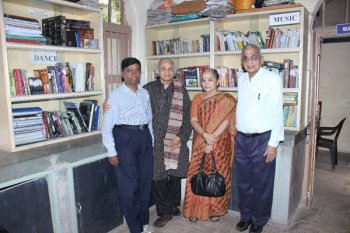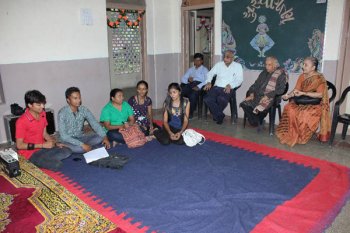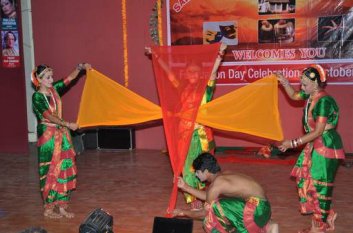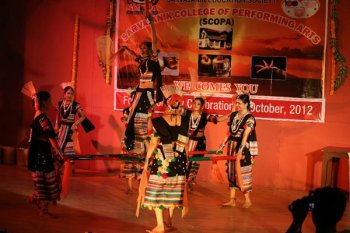
|   |

|   |
Visiting Surat in South Gujarat - Dr. Sunil Kothari e-mail: sunilkothari1933@gmail.com October 26, 2012 Being a former Professor and Chair of the Dance Department, Rabindra Bharati University, Kolkata and Dean and Professor of School of Arts and Aesthetics, Jawaharlal Nehru University, New Delhi, I am often invited to give lectures at various universities where there are dance departments. I am a Gujarati, and have earned my Ph. D in Dance from M.S. University of Baroda; my major work in dance research and studies has been of pan Indian nature. Though I have given lectures at Dance Dept and Fine Arts Faculty, M.S. University, Baroda and occasionally at Ahmedabad, I had so far not visited Surat. By a happy coincidence, the newly established Sarvajanik College of Performing Arts (SCOPA) invited me for the Foundation Day (8th October) of their Sarvajanik Education Society for two days - to conduct a workshop in dance on 7th October and give a keynote address on 8th October. I was away in Guwahati attending the Book Fair organized by Publication Board, Assam, but returned to honour my commitment and meet the faculty members of the two year old college of performing arts with graduate programs in dance, drama and music. The Chairman of SCOPA, Rajanikant Marfatia, my host, was keen on my interacting with the students as well as with other officers of the college for suggestions on developing the course and the difficulties institutions face when they start courses in performing arts. Rajanikant Marfatia is a dynamic person, past President of The South Gujarat Chamber of Commerce and Industry, Surat, Chairman of SCOPA and connected with Reliance Industries Ltd, a visionary who did not leave any stone unturned to see that Surat had an airport and connected with Delhi and Mumbai. When I arrived by early morning flight at Surat and saw the svelte new airport, I was much impressed. Leave alone the efforts for placing Surat on air route, Rajanikant bhai's interest in educational activities are very deep and I realized that lack of money or financial assistance are not major issues. The enlightened leaders and social workers in Surat have been donating funds. And today Surat with its progress has acquired a reputation with UNESCO as the major eighth city of India. I came to learn a lot about Surat, which one associates primarily with diamond polishing industry and textiles. We Gujaratis have a popular proverb: Surat nu jaman ane Kashi nu maran. The food of Surat is unparalleled and to die in Kashi is the ultimate aim. I must admit that right from the sumptuous morning breakfast, lunch till dinner, I was treated with tasteful dishes only Surat can provide. I realized what I have been missing being a 'gujju bhai.' The University in Surat has been named after the legendary Gujarati poet Narmad as Veer Narmad South Gujarat University (VNSGU). I was given accommodation at the sprawling campus with a latest state-of-art auditorium. Since I was anxious to meet the students and faculty members, my lecture and screening of excerpts of dance clippings were scheduled at 11am in the morning at the campus where the well known M.T.R College is situated and where the College of Performing Arts is located in a heritage building. Dr. Archana Dixit, a musicologist from Banaras Hindu University (BHU) is a Director of the College with special permission of the Board to look after all details and necessary requirements of the new faculty of Performing Arts. She recalled when we had met many years ago at BHU. It was indeed a pleasure to connect with her again.
I have been to many colleges and Universities within India and abroad, but this was my very first visit to SCOPA in Surat. It was indeed extremely heartening to learn that the two year old Performing Arts section has made several strides. The college is run by Sarvajanik Education Society started in 1912 and is currently celebrating its 100th year of existence. They have three undergraduate programs viz., Bachelor in Performing Arts (BPA) in Dramatics, in classical dance (Bharatanatyam) and classical vocal. The college was started in 2010 and is the only institution in South Gujarat offering degree courses in Performing Arts. It is affiliated with VNSGU. On the next day, the three different departments made their presentations giving account of their activities, in particular, the Drama Department with its power point presentation. I realized that the Drama Department has won many awards and have joined workshops at National School of Drama (NSD). The young and dynamic Murtaza Railwaywala is a brilliant actor and along with his other classmates has done his department proud. Dance Faculty students have won many prizes and some of the students and staff members have won Gujarat State Sangeet Natak Akademi awards for their contribution to dance in Gujarat. I was asked to honour Rita Choksi, the Kuchipudi teacher who was awarded Gujarat Gaurav Puraskar by the Gujarat State Sangeet Natak Akademi. She is a disciple of Smita Shastri, who studied it from traditional Andhra natyacharya C.R. Acharyalu at Darpana Academy of Dance of Mrinalini Sarabhai. Both Mallika Sarabhai and Smita Shastri have studied it directly under Acharyalu. Smita Shastri runs her own Nartan Academy of Dance teaching Kuchipudi for past many years and has contributed to popularizing Kuchipudi in Gujarat. In the morning before my workshop, I was taken to the heritage building to meet staff members and see the library and other facilities. The students of the music faculty rendered classical bandishes for us as Dr. Archana Dixit was keen to explain how the music faculty works. The library has several books on Indian classical dances and also drama and music. The collection was impressive. Also the college has a recording studio with perfect sound system and in future they wish to develop it further. As and when they shall have more funds, they shall move to a new building. At present the rooms necessary for dance, drama and music seemed enough but with expansion they would need more space.  The library: Naresh Kapadia, Dr. Sunil Kothari, Dr Archana Dixit, Rajanikant Marfatia  The campus: Naresh Kapadia (former Prof. at the college), Rajanikant Marfatia (Member of Executive Board), Dr. Sunil Kothari, Dr. Archana Dixit (Director) The gathering of students of all the three faculties was held at another hall in the campus. A number of them attended my lecture, which was mainly on courses taught in the universities and sharing with them great traditional masters' classes and performances through a documentary film titled Parampara, which Prakash Jha had made many years ago during the halcyon days of Festivals of India abroad in several countries. Ameeshree, a disciple of Prof CV Chandrasekhar, when he was teaching at Faculty of Performing Arts at M.S. University, Baroda, is now teaching Bharatanatyam. Therefore, the Kalakshetra bani is being carried on at Surat. Theory classes are also held and questions were asked about padarthabhinaya and vakyarthabhinaya, prabandha and so on. There are dancers who are running private classes and dancers above forty years also wish to perform, which is a good sign. Their issues of internal competition are common to all dancers and the best solution I suggested to them was to work out amongst them the performance schedules. Some private teachers wanted to know how to work out dance training course for their students ranging from age group of eight to twenty years. One major problem seemed to be that of appointment of mridangam artiste for Bharatanatyam classes. The problem seems to be a major hurdle as no percussionist, expert mridangam players from South India wish to settle down in Gujarat. Even at M.S. University of Baroda, this problem remains unresolved. Unless higher salary is fixed as a special case, it would be difficult to attract a percussionist to come to Gujarat, despite the fact that arangetrams are held regularly during the year. It seems that they manage to get a mridangist for arangetram by inviting him in advance for a period for practice and once the event is over the mridangist leaves. Rajanikant Marfatia suggested that parents should consult each other about arangetrams and when they are held during the course of the week, the mridangist could be asked to come for a longer period of stay and be of help to the dance department. They thought about it but also complained that the mridangist is always in a hurry to leave. I suggested they should get in touch with Darpana Dance Academy in Ahmedabad and take advice from Mrinalini Sarabhai and Mallika. Baroda, Ahmedabad and Surat now have colleges where Bharatanatyam is taught and these three cities could work out how to get the services of a mridangist. I have suggested to Shri Marfatia that the Board should pass a resolution for higher financial perks as a special case. In practice, unless there are students also who wish to learn mridangam in Surat and elsewhere, the mridangist will have no interest in staying in Gujarat. This indeed is a serious lacuna, as students want to practice with mridangam. At present they practice to tattukali, the wooden plank and stick with which the teacher keeps rhythm. Questions also came up about the availability of theoretical books on dance. For that we have decided to exchange notes and the department to start getting journals like Sruti, Nartanam, Sangeet Natak Akademi journal, The Music Academy Journal etc and have access to www.narthaki.com for general information on dance world over. Since the college is only two years old, the teething troubles would be there but by remaining in touch with other universities and dance institutions, SCOPA would also join the mainstream, as the enthusiasm is heartening. Professors, teachers and leading dancers from Ahmedabad and Baroda regularly visit the Department and also as examiners. They have invited artistes from out station and would like to continue it for future. Till the university completes the required period for enlisting support from University Grants Commission, SCOPA will have to make do with whatever best they can in terms of development of the three departments that are quite dynamic and forward looking. That is a very healthy sign. By a happy coincidence, the renowned Kathak exponent Shovana Narayan was touring Gujarat under the aegis of SPIC MACAY. Her lec-dem was held in the auditorium just opposite University Guest House. It was a pleasure to attend the lec-dem and meet local Kathak exponents and also the organizers who continue SPIC MACAY activities. It is one movement which has brought at the very doorsteps of various schools and colleges, celebrated artistes to introduce their art to students and interested local artistes. Besides explaining the basic of nritta and abhinaya, Shovana displayed her command over the technique and won over the audiences with storytelling of Maithili Sharan Gupt's Yashodara's lament 'Sakhi who kahe ke to jaate?' Buddha's renunciation and leaving Yashodhara when asleep, was performed with intense feeling. Later on, when Buddha arrives asking for alms, Yashodara reconciles and joins him. Shovana has performed this episode many times and to the high literary Hindi text of the well known Hindi poet. Such presentations appeal to diverse audiences and show how Kathak can explore the literary elements in place of traditional repertoire. Shovana also explained the evolving patterns of Kathak costumes from evidences of sculptures from Bihar. Kathak costumes are not necessarily standardized, as are Bharatanatyam costumes, but have evolved over the years, aesthetically designed in present times. She also explained the prahelika, question built in a four stanza kavit like 'Kis Karan kamini hath jalyo?' The pleasant confusion of a newly wedded nayika, unaware of the love game, with her first encounter with her beloved, is shy, bashful and little frightened, when in the bedroom the lover draws her close and her clothes get disarrayed. In confusion she places her palm on the lamp and extinguishes it. Thus her palm is burnt. It is a lovely romantic poem and is often performed by senior dancers. Next day on 8th October I delivered my keynote address and with the help of Murtaza Railwaywala, screened excerpts of the film Kalpana by Uday Shankar. He was very interested in Uday Shankar's choreography of Labour and Machinery. Being a drama student he found that the time frame of Uday Shankar's work and other dramatists was very important. Invariably the excerpts of Kalpana impress the audience and in particular senior citizens, as many of them have memories of having seen Uday Shankar. He was far head of his time and in the film, through dance he has raised issues of education under British rule, unemployment, exploitation of labour class by the capitalist class, the mill owner wanting the labour class to work like machine and the most memorable choreography by Uday Shankar of that segment remains unparalleled. Naresh Kapadia conducted the program introducing the chief guest and dignitaries.  Ganapati dance: Ameeshashree Desai, Preety Baniya, Shivani Dudhwala and male dancer Alpesh Bhoj  Bamboo dance: Puravi Desai, Ameeshashree Desai, Jyoti Jariwala, Binal Jariwala, Manali Natali and others One learnt a lot about the activities of the three departments. The presentation of brief items of dance, in particular of Ganapati was imaginative. Taking two colourful cloths and holding them like a cross, the image of Ganapati was imaginatively enacted. The use of lazim brought the Maharashtrian touch as during Ganapati puja, the young perform with lazim. The dancers performed gracefully. Premchandra Bhagat, who was the chief guest, reassured that he shall willingly give whatever help the college would need. The various members of the Board, former Vice-Chairman and other members present were all keen to see that college education in performing arts should spread among the youth. Since I had to leave by 9pm, I could only see a few presentations. But from the conversations with Board members of SCOPA, I could see that all were geared to having Performing Arts Faculty become more known outside South Gujarat. I have no doubt that it is bound to be with gifted students participating nationally. I promised to visit again and left Surat with happy memories. During the day, Marfatia took me to Gopipura, the well known quarter of old Surat, where literary activities are held. We went to meet Nanubhai Nayak, who at the age of 86, continues to supervise his large empire of Sahitya Sangam publications with the help of his son and a dedicated staff. The entire building is occupied for publications and also for literary functions. Jugalbandi, my book of travelogue with Chandravadan Mehta is to be published by Nanubhai Nayak. He recalled meeting Suresh Joshi and other Gujarati writers who invariably visit him during their stay in Surat. Nanubhai presented us two latest volumes he has written in Gujarati. The next stop was lunch at Sree Rama Krishna Export Diamond Empire, a sprawling well designed building where diamond polishing is done and advanced state of art technique is employed. Using latest technology for air conditioning, with a provision for helipad on the terrace, the four story building was spic and span. A young employee received us courteously and took us around various divisions, explaining how diamond polishing is undertaken, with advanced innovative methods, its export, future plans, branches abroad, and Sree Rama Krishna Trust, its educational, health care activities, charity, donations and the library where one can study more about the diamond industry. We were to take lunch with the Chairman Govind Dholakia and were taken to meet him. An unassuming person with polite manners, he welcomed us warmly. Marfatia and he are old friends. They had worked together to see that Surat was linked by air. Govindbhai's life story is amazing. From small beginnings, today he has built an empire of diamond polishing and export with his partners and continues to offer services through trust for education, healthcare, social services, water conservation, environment awareness, tribal welfare, aid to disabled, natural calamities aid, and takes care of his large staff. The employees take lunch daily at the office canteen along with the Chairman, everything is clean and works smoothly. I was deeply impressed. I was given two books Diamond Education and Beyond and Shree Rama Krishna Charitable Trust, which opened my eyes to this unique institution which whole heartedly with their skill cooperates with Govind Dholakia, in transforming rough diamonds into the polished reality! A few years ago when Surat was caught in the plague, people were skeptical of visiting the place. But today, Surat has a different identity and ranks among the finest cities. And people are anxious to see that it does not lag behind in developing the performing arts.  Dr. Sunil Kothari is a dance historian, scholar, author and a renowned dance critic. He is Vice President of World Dance Alliance Asia Pacific India chapter, based in New Delhi. He is honored by the President of India with Padma Shri, Sangeet Natak Akademi award and Senior Critic Award from Dance Critics Association, NYC. He is a regular contributor to www.narthaki.com, the roving critic for monthly magazine Sruti and is a contributing editor of Nartanam for the past 11 years. Post your comments Pl provide your name and email id along with your comment. All appropriate comments posted with name and email id in the blog will also be featured in the site. |